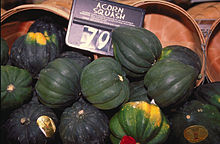- Acorn squash
-
Acorn squash (Cucurbita pepo), also called pepper squash[1] or Des Moines squash,[2] is a winter squash with distinctive longitudinal ridges and sweet, yellow-orange flesh. Although considered a winter squash, acorn squash belongs to the same species as all summer squashes (including zucchini and yellow crookneck squash).
The most common variety is dark green in color, often with a single splotch of orange on the side or top. However, newer varieties have arisen including Golden Acorn, for its glowing yellow colour, and some that are white. They can also be variegated (multi-colored).[3] As the name suggests, its shape resembles that of an acorn. Acorn squashes typically weigh one to two pounds and are between four and seven inches long.[2] Acorn squash is good and hardy to save throughout the winter in storage, keeping several months in a cool dry location such as a cold cellar.
Acorn squash is very easily grown. Seeds are started after all danger of frost is past and the soil is warm or within 3–4 weeks before the predicted last frost date in the area. Seeds directly sown are placed one inch deep, 5-6 to a hill; hills are 6 feet in all direction from other hills. As with other squash varieties, the acorn squash produces yellow trumpet flowers which are also edible. The stem has a prickly feel, so be careful when handling the plant. Roughly 85 days after germinating, acorn squash are ready to be harvested. Curing takes a week to ten days in a sheltered area outside, or a warm dry place like a dry storage space, protected from frost.
Acorn squash is most commonly baked, but can also be microwaved, sauteed or steamed. It may be stuffed with rice, meat or vegetable mixtures.[3] The seeds of the squash are also eaten, usually after being toasted. This squash is not as rich in beta-carotene as other winter squashes, but is a good source of dietary fiber and potassium, as well as smaller amounts of vitamins C and B, magnesium, and manganese.
Indigenous to North and Central America, the squash was introduced to early European settlers by Native Americans.[3]
References
- ^ "Growing winter squash". August 2011. Weekend Gardener. http://www.weekendgardener.net/vegetables/squash-winter.htm. Retrieved 14 August 2011.
- ^ a b Mariani, John F (1999). Encyclopedia of American Food and Drink. Lebhar-Friedman Books. p. 2. ISBN 0867307846.
- ^ a b c Zeldes, Leah A. (2010-10-20). "Eat this! Acorn squash, made for stuffing". Dining Chicago. Chicago's Restaurant & Entertainment Guide, Inc.. http://www.diningchicago.com/blog/2010/10/20/eat-this-acorn-squash-made-for-stuffing/. Retrieved 2010=11-17.
- O'Connell, Mary; Jim Stefon, Sal Briones, Joe Meier, Laura Haas (June 5, 1998). "Squash Cucurbita spp.". Crop Plant Resources. New Mexico State University, Molecular Biology Program. http://research.nmsu.edu/molbio/plant/squash.html. Retrieved 2010-11-25.
External links
Squashes and pumpkins Squashes Acorn squash • Big Max • Butternut squash • Cucurbita • Cucurbita maxima • Gem squash • Kabocha • Pattypan squash • Red kuri squash • Spaghetti squash • Summer squash • Winter squash • Yellow crookneck squash • Yellow summer squash • ZucchiniPumpkins 1068 Wallace • Atlantic Giant • Cucurbita • Hitlerszalonna • Prizewinner • Pumpkin chunking • Pumpkin pie • Pumpkin queen • Pumpkin soupCategories:- Squashes and pumpkins
Wikimedia Foundation. 2010.


